Illinois Crop Update – July 5, 2024
Russ Higgins – Commercial Agriculture Educator
Grundy County
Soil Conditions: Near Normal
This past week I had the opportunity to travel a larger area of northern Illinois. Generally, both corn and soybean crops appear to be in good shape. This comes as somewhat of a surprise when considering what the crop has endured to this point (near midway) in the growing season. Earliest planted crops include R1 corn and R2 soy. In recent trips across the countryside, I see acres of soy and often come across a field that from a windshield survey appears to be suffering from dicamba drift, so much so that I stop and visit the field. Recognize that we are far removed from the June 12th application deadline of soy dicamba chemistry and most post corn applications. Yet the HG 4 (growth regulator) symptoms are showing up on new trifoliate leaves in many northern Illinois fields. Some fields I know, and most I expect, are Enlist beans. Why are we still getting the wrinkling and white tipped leaves? This may turn into an insect year, while scouting this week my checklist included western corn rootworm beetles, northern corn rootworm beetles, bean leaf beetles, Japanese beetles, potato leafhoppers and grasshopper nymphs.

Figure 1: HG 4 growth regulator symptoms on soy
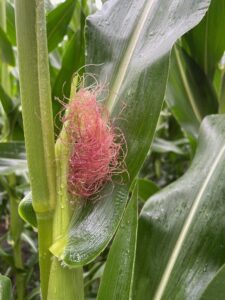
Figure 2: R1 corn
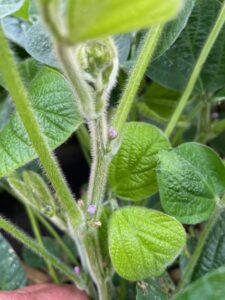
Figure 3: R2 soy
Talon Becker – Commercial Agriculture Specialist
Champaign County
Soil Conditions: Mildly Dry (soil is drier than normal, plant growth may have slowed)
I took a loop around northern Champaign County this week. With the exception of seed corn fields, all corn I saw was at least V7 or larger, with most in the V10-V12 range. Many fields are showing tassels, and I found one field at full R1 with silks emerged and pollen shedding. Soybeans were anywhere from recently emerged, generally in an apparent replant situation, to R2. Despite the wet conditions that caused these delayed plantings, conditions are now a bit on the dry side in that part of the county. Although not visible in every field, a good portion of the corn fields were showing some rolled leaves in the mid-afternoon heat. The issue was not widespread quite yet, and soil moisture could be found only a few inches deep in most fields I visited. But that said, I think most would welcome a nice 0.5-1 inch rain shower in the coming days.
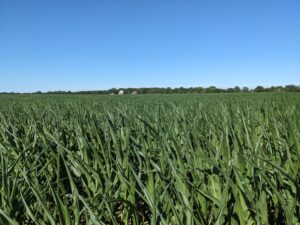
Figure 4: Corn field ~V10 showing signs of moisture stress
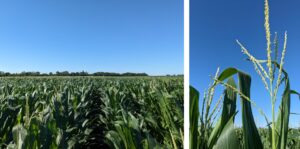
Figure 5: Corn field at R1 (left) and tassel undergoing anthesis (right)
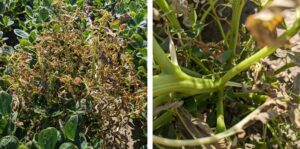
Figure 6: Approximately 24-inch tall waterhemp attempted to be controlled by herbicides but showing
regrowth at axillary meristems
Reagan Tibbs – Commercial Agriculture Educator
Logan County
Soil Conditions: Near Normal
Not much has changed in the way of crop growth across Logan, Menard, and Sangamon counties over the last week. Nearly all of the earlier-planted corn has tasseled, with the rest of the corn crop not too far behind in some areas. Soybean growth remains strong as well. Some insect damage can be found on leaves, but nothing that will affect yields at this moment.
Doug Gucker – Local Food Systems and Small Farms Educator
Dewitt, Macon, and Piatt County
Soil Conditions: Mildly Dry (soil is drier than normal, plant growth may have slowed)
The rainfall has been quite variable across my 3-county area with some areas receiving less than 25% of normal and other areas with near-normal precipitation. In the dry areas, crops are showing moisture stress in the heat of the day. Early planted corn is in the R1 stage, silking. Wheat harvest is done and double-crop soybean planting is finished; this is early for my part of the state.
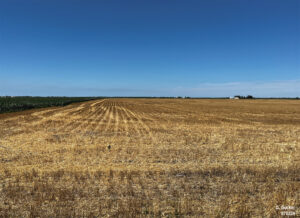
Figure 7: The wheat is harvested and the double-crop soybeans are planted.
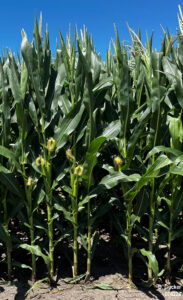
Figure 8: Early planted corn is now silking.

Figure 9: In the areas where the rains have been sparse, both early and later
planted corn fields are showing moisture stress.
Luke Merrit – Agricultural Research Specialist
Pike County
Soil Conditions: Near Normal
The rain that we got late last week was welcomed with corn starting to tassel. This week, most of the corn around here has tasseled and has silks out. Soybeans are entering the R3 stage as plants are putting little pods in the upper nodes. For the month of June at the Orr Center, rainfall was less than 50% of what we normally get. Hopefully we get more rainfall this week to further help the crop.





